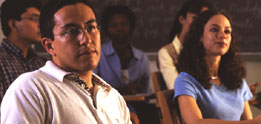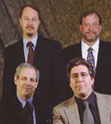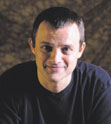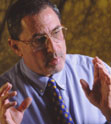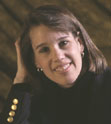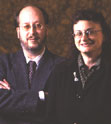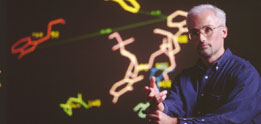 |
||||||||||||||||||||||
|
Leading. Leading. Leading. Leading.
Leading. Leading.
|
||||||||||||||||||||||||||||||||||||
|
We cannot look back over 2001 without mentioning Tropical Storm Allison, the worst natural disaster ever to strike the University of Houston. Ninety of our 105 buildings were damaged. Losses are estimated to cost $75 to $95 million and include facilities, equipment, books, business income, and vital faculty research programs. But difficult times often give rise to great
leaders. Who can forget the extraordinary leadership demonstrated
by Associate Vice President for Plant Operations Dave Irvin, who
worked around the clock to coordinate the pumping of more than two
million gallons of water Our ability to weather the storm, to finish summer courses on time, and to make an almost seamless transition into the fall semester was due to the outstanding contributions of these and other leaders far too numerous to mention here. However, to focus on these extraordinary times would be to overlook those who have led in the daily teaching, research, and service activities that are the real foundation of our University. Leading the University in research dollars for a single department this past year has been the Department of Biology and Biochemistry, garnering over $6 million in research funding. Out of their thirty-one faculty members, twenty-eight have active research programs, many of them nationally funded and many gaining national attention. For example, the Biological Clocks Program – composed of John and Rebecca Moores Professor Stuart Dryer, Professors Arnold Eskin, Michael Rea, and Paul Hardin, and Associate Professor Gregory Cahill – received more than $1.5 million to continue research on molecular clock mechanisms in animal nervous systems. Assistant Professor Patrick Callaerts received a $1.1 million grant from the National Institutes of Health (NIH) for his study of the developing brain in the fruitfly Drosophila. A $1.1 million NIH grant was awarded to Professor Eskin to study glutamate uptake during learning in the vertebrate brain. Assistant Professor Susan Martinis received a series of grants, ranging from $25,000 to more than $1.3 million, for her study of RNA-protein interactions at the molecular level. Perhaps the most publicized achievement has been Assistant Professor Susan Hardin’s groundbreaking DNA sequencing technology, which offers a faster and less expensive way to determine the order of basis in a DNA molecule. She teamed with James Briggs, assistant professor of biochemistry, Xiaolian Gao, associate professor of chemistry, Shiao-Chun Tu, the John and Rebecca Moores Distinguished Professor of Biochemistry, and Richard Willson, associate professor of chemical engineering, to found VisiGen Biotechnologies, Inc., which received nearly $4 million last year to develop this technology. With its leaders in innovative research, funding,
and national recognition, Biology and Biochemistry has developed
into a world-class department. So what is its secret? How does a
department achieve such impressive new heights in leadership? “Synergy”
is the simple answer proffered by Department Chair Dan Wells. The
department has This power of synergy has influenced other research areas at UH as well. In October 2000, Professor David Francis in our Department of Psychology received a $12.8 million grant from the Office of Educational Research and Improvement and the National Institute of Child Health and Human Development to study oral language proficiency, literacy, and literacy-related skills in elementary school students. This past year, he received a $4.8 million supplement to this grant and was awarded $4.4 million from the same source to investigate “Biological and Behavioral Variation in the Language Development of Spanish-Speaking Children.” With this study, Professor Francis will research the role primary language plays in literacy and cognitive development when children are learning to read in more than one language. For both of these large-scale projects, Professor
Francis will work with researchers at the University of Texas at
Austin, Temple University, California State University at Long Beach,
the University of Wisconsin, and with two former UH colleagues,
Dr. Jack Fletcher and Dr. Barbara Foorman, who are now associated
with the UT-Houston Health Science Center. Professor Francis attributes
much of his success to the |
|||||||||||||||||||||||||||||||||||
|
|
Next Page | |||||||||||||||||||||||||||||||||||
| Previous Page | ||||||||||||||||||||||||||||||||||||
